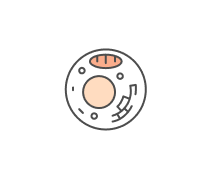The basic unit of all living things is the:
Human cells reproduce by mitosis, dividing into two identical cells...
The heart is the organ that circulates the body's:
The lungs supply ___________ to the blood.
The organs that control the body's vision are the
The connection between two or more bones is called a:
The oval, bony case that protects the brain is the:
The ___________ is the protoplasm of a cell except for the protoplasm...
The foot is made up of ________ bones.
The largest artery in the human body is the:
The organ that controls the body is the
The two bones that form the sides and crown (top) of the cranium are...
The inner and larger bone in the forearm, attached to that writed and...
Osteology is the study of the anatomy, structure, and function of the:
Blood __________ the body's temperature.
The constructive phase of metabolism is called:
The __________ systems forms the physical foundation of the body.
The maxillae bones form the:
The dense active protoplasm found in the center of the cell is
The __________ system changes food into nutrients and wastes.
The part of the muscle that does not move is the:
The __________ are the muscles that straighten the wrist, hand and...
White blood cells are also known as:
The _________ system enables breathing, supplying the body with oxygen...
The organs that excretes water and waste products are the:
Sensory nerve endings called ____________ are located close to the...
The chemical process through which cells are nourished and carry out...
The _________ system controls the steady movement of the blood through...
The study of the human body structures that can be seen with the naked...
Neurology is the study of the structure, function, and pathology of...
Valves are structures that temporarily close a passage or permit blood...
The ____________ is the larger of the two bones that form the leg...
The broad muscle that covers the top of the head is the:
The greater occipital nerve is located at the _________ of the head...
The main blood supply of the arms and hands are the:
What methods are commonly employed for the study of anatomy,...
Physiology is the study of the functions and activities performed by...
Which muscles are also known as the smooth muscles?
The ________ are the organs that digest food.
Which type of tissue lines the heart and the digestive and respiratory...
The _______ drain(s) the tissue spaces of excess interstitial...
Digestive ________ are chemicals that change certain types of food...
The ________ system controls the processes by which plants and animals...
Which type of tissue contacts and move various parts of the body?
Which one do you like?
The study of the nature, structure, function, and diseases of the...
The _________ system serves as a protective coating and helps regulate...
The __________ system purifies the body by the elimination of waste...
The __________ is a gland of the endocrine system that secretes...
The ________ cranial nerve is the chief motor nerve of the face.
The _____________ supplies blood to the muscles of the eye.
The ____________ system protects the body from disease by developing...
The muscles at the base of the fingers that draw the fingers together...
The study of tiny structures found in living tissues is known as...
The ____________ is the primary nasal muscle of concern to...
Deoxygenated blood flows from the body into the:
The _________ system controls and coordinates all other systems inside...
The popliteal artery supplies blood to the foot and divides into two...
The mental nerve affects the skin of the:
The system of nerves that carries impulses or messages to and from the...
The ___________ system covers, shapes, and supports the skeleton...
The median nerve supplies impulses to the:
The deep peroneal nerve is located in the
The ____________glands secrete about 30 steroid hormones and control...
The _______ system affects the growth, development, sexual functions,...
















